Centralitatea pandemiei de COVID-19 ca eveniment traumatizant la studenţii medicinişti
Centrality of the COVID-19 pandemic as a traumatic event in medical students
Abstract
The detrimental psychological impact of the COVID-19 pandemic is more intense in youth, female sex, single persons and in those with a prior history of exposure to trauma or chronic illness. Medical students experience a higher level of exposure to the negative impact of the pandemic. The aim of the study was to evaluate the association between the interpretation of the pandemic as central traumatic event – i.e., life-changing, before and after’ turning point in life – and the sociodemographic factors, the perceived stress and the risky behaviours, respectively, in Romanian medical students. A total of 204 Romanian medical students from the “Iuliu Haţieganu” University of Medicine and Pharmacy, Cluj-Napoca, with the median age of 21 years old (80.4% female, 56.9% single, 37.3% with prior exposure to trauma, 6.9% with chronic illnesses, and 48% volunteers during the pandemic) completed an online questionnaire, including a demographic survey, Centrality of Event Scale, Perceived Stress Scale, Risk Taking and Self Harm Behaviours Inventory, in the period April-May 2021. The reported life-transforming level of the COVID-19 pandemic in the Romanian medical students evaluated one year after the first wave lockdown measures is directly associated with the level of perceived stress, overall and in male students. The higher the participants’ level of agreement with the assessment that the pandemic is a negative event, the higher its reported life-transforming level. The participants who totally disagree with the assessment that the pandemic is a negative event report lower life-transforming levels for the pandemic, compared with counterparts who assess the pandemic more negatively. Patricipants’ age, study year, partnership status, prior history of trauma exposure and chronic illness, self-harm, risk taking and volunteering are not associated with the reported life-transforming level of the pandemic.Keywords
COVID-19 pandemicmedical studentsRomaniaevent centralityperceived stressRezumat
Impactul psihologic negativ al pandemiei de COVID-19 este mai intens la tineri, la sexul feminin, la persoane singure (ca statut partenerial), cu antecedente de expunere la traumă sau cu boli cronice. Studenţii medicinişti au o expunere mai ridicată la impactul negativ al pandemiei. Scopul acestui studiu este evaluarea asocierii dintre interpretarea pandemiei ca eveniment traumatic central – adică transformator de viaţă, de cotitură şi împărţire a vieţii în „înainte” şi „după” – şi factori sociodemografici, stresul perceput şi comportamentele de risc la studenţi medicinişti români. 204 studenţi la Medicină, de la secţia de limba română, din cadrul Universităţii de Medicină şi Farmacie „Iuliu Haţieganu” din Cluj-Napoca, cu vârsta medie de 21 de ani (80,4% fete, 56,9% singuri, 37,3% cu antecedente de expunere la traume, 6,9% cu boli cronice, 48% cu voluntariat în pandemie) au completat un chestionar online cu întrebări sociodemografice, Scala de Centralitate a Evenimentului, Scala de Stres Perceput şi Inventarul de Asumare de Riscuri şi Autovătămare, în perioada aprilie-mai 2021. Nivelul transformator de viaţă al pandemiei de COVID-19 la studenţii români evaluaţi, la un an după măsurile de restricţie maxime din primul val, se asociază direct cu nivelul de stres perceput la întreg lotul şi la sexul masculin, fiind cu atât mai mare, cu cât aceştia sunt mai puternic de acord că pandemia este un eveniment negativ. Studenţii medicinişti care nu sunt deloc de acord că pandemia este un eveniment negativ raportează că pandemia le-a transformat viaţa în mult mai mică măsură decât colegii care evaluează mai negativ pandemia. Vârsta, anul de studiu, statutul partenerial, istoricul de expunere la traume şi boli cronice, asumarea de riscuri, autovătămarea şi voluntariatul ca formă de conectare socială nu se asociază la studenţii medicinişti evaluaţi cu măsura în care pandemia le transformă viaţa.Cuvinte Cheie
pandemia de COVID-19studenţi mediciniştiRomâniacentralitatea evenimentuluistres perceputIntroduction
The COVID-19 pandemic is an ongoing, life-transforming global event, an individual and community trauma of a shockwave nature, as supported by trauma exposure studies, with an unpredictable evolution and many unforeseeable consequences for individual and community mental health(1). Current data ascertain that the detrimental psychological impact of the pandemic is more intense in youth, female sex, single persons and in those with a prior history of exposure to trauma or chronic illnesses(2).
The psychological impact of the pandemic in youth reflects in the elevated levels of perceived stress, traumatic stress and increase of self-harm behaviours, including problematic substance use and eating(3). During the pandemic, medical students comprise a group of youth in a specific context which entails additional factors influencing their experience of the event. The medical students are an important resource in the pandemic, as volunteers in the increasingly strained health services, which bring opportunities for social connectedness, and also more exposure to the medical, psychological and social strain of COVID-19 because volunteering consists of direct interactions with patients(4). More specifically, medical students report increased levels of social, academic and health-related stress, depression, anxiety and coping difficulties, mostly regarding COVID-19 exposure and online learning, compared with students in other academic fields(4,5).
The perspective on the COVID-19 pandemic as central event – i.e., global turning point with an increased, still unfolding and unforeseeable life-altering potential – may provide insights regarding mental health risk factors in medical students(6).
Aim
To evaluate the association between the interpretation of the pandemic as central traumatic event – i.e., life-changing, “before and after” turning point in life – and sociodemographic factors, perceived stress and the risky behaviours, respectively, in Romanian medical students.
Materials and method
The authors conducted a cross-sectional, observational study in the “Iuliu Haţieganu” University of Medicine and Pharmacy, Cluj-Napoca, Romania, between the 15th of April 2021 and the 15th of May 2021, one year after the national lockdown measures for the first wave of COVID-19. Two hundred and four students from the Faculty of Medicine, the Romanian department, of the university participated in the study.
Due to the context of the COVID-19 pandemic and the physical distancing measures, with online and hybrid learning provisions for the target population, the participants were approached online and completed online the questionnaires. We used the following measures:
Demographic survey with questions regarding age, sex, year of study, relationship status, history of exposure to psychological trauma and chronic illness prior to the pandemic, volunteering during the pandemic, and overall assessment of the pandemic as negative event on a 5-point Likert scale (1 totally disagree, 2 partially disagree, 3 neutral, 4 partially agree, 5 totally agree).
The Centrality of Event Scale (CES), a self-assessment tool with 20 items, scored on a 5-point Likert scale from 1 (totally disagree) to 5 (totally agree), measures the degree in which a traumatic event is coded in the memory as a reference point for one’s identity, life meaning, reference point for other life experiences, and a turning point in one’s life. The total score is the sum of the item scores, measuring the degree in which the event is percieved as life-altering, and may range between 20 and 100(7). We instructed the participants to answer by referring to the COVID-19 pandemic as the event in question.
The Perceived Stress Scale (PSS), the 14-item version (PSS-14), a self-assessment tool with 14 items, scored from 0 (never) to 4 (very often) in the items concerning perceptions of stress, and 0 (very often) to 4 (never) in the items concerning perceptions of effective coping with stress, measuring how frequently the respondent perceives various life situations in the past month as stressful. The PSS total score is the sum of item scores, and may range from 0 to 54(8).
Risk Taking and Self Harm Inventory (RTSHIA), a self-assessment tool with 38 items, developed for adolescents, scored from 0 (never) to 4 (many times), measuring the frequency of a wide range of risk-taking and self-harming behaviours. It includes two subscales, Risk Taking (RT; 8 items: 3, 4, 5, 6, 7, 10, 11, 12) and Self Harm (SH)(9). Since participants belonged to the youth age group, and the range of behaviours assessed was the most comprehensive, compared with other self-harm tools, we identified RTSHIA informative for the purpose of the study, retained the first 31 items for the study and items 13-20, 23, 25 and 27-31 for the SH scale, we excluded the items about behaviour severity and suicidality, and we used the past month time reference for reporting.
We used the Statistical Package for Social Sciences Version 21 to perform the statistical analysis of the data collected in the study. We used the one-sample Kolmogorov-Smirnov test to assess the distribution of the quantitative variables in the sample, Pearson’s or Spearman’s correlations, as necessary, to assess correlations between quantitative variables, and Levene’s test for variances, Student t-test for independent samples or one-way Anova, as necessary, to compare samples.
Results
The age of participants ranged from 19 to 27 years old (median age: 21), 80.4% of the sample were females, 56.9% were single, 37.3% had a history of exposure to psychological trauma prior to the pandemic, and 6.9% had a history of chronic illness. Furthermore, 48% of the sample reported involvement in volunteering in the year prior to assessment. The distribution of the participants according to study year is presented in Figure 1. The distribution of the participants according to the level of agreement to the assessment of the pandemic as negative event is presented in Figure 2.
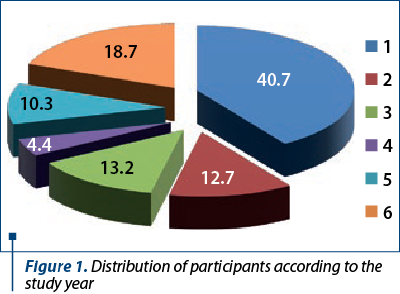
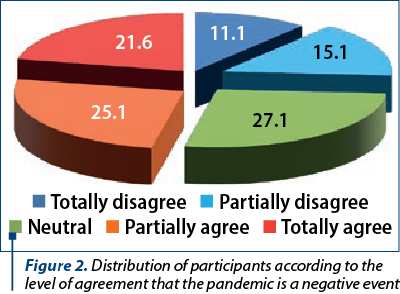
The mean score for CES in the sample was 53.24 (SD ± 16.968). The median scores in the sample were 29 for PSS (scores ranging from 8 to 50), 3 for RT (scores ranging from 0 to 23), and 1 for SH, respectively (scores ranging from 0 to 44).
The CES scores in the total sample were positively correlated with the PSS scores (p<0.01, Pearson’s r = 0.235), RT scores (p=0.222, Spearman’s rho = 0.103), SH scores (p=0.154, Spearman’s rho = 0.120), and negatively correlated with age (p=0.409; Spearman’s rho = -0.070).
In male participants, the CES scores were positively correlated with the PSS scores (p=0.016, Pearson’s r = 0.423), RT scores (p=0.214, Spearman’s rho = 0.226), and negatively correlated with the SH scores (p=0.861, Spearman’s rho = -0.032).
In female participants, CES scores were positively correlated with PSS scores (p=0.057, Pearson’s r = 0.182), RT scores (p=0.486, Spearman’s rho = 0.067), SH scores (p=0.109, Spearman’s rho = 0.154). Moreover, in female participants, the SH scores were directly correlated with the RT scores (p<0.01, Spearman’s rho = 0.275), respectively PSS (p<0.01, Spearman’s rho = 0.320)
We further compared the CES scores in participants according to sex (Figure 3), year of study (Figure 4), relationship status (single or not – Figure 5), prior history of traumatic events (Figure 6) and cronic illness (Figure 7). Additionally, we compared the CES scores according to volunteer status during the pandemic (Figure 8) and the level of agreement with the assessment that the pandemic is a negative event (Figure 9).
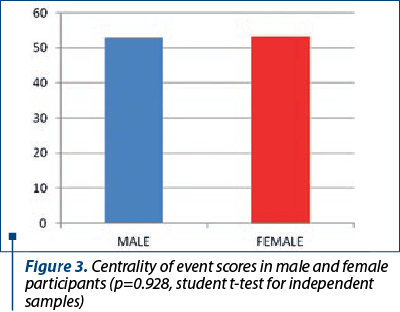
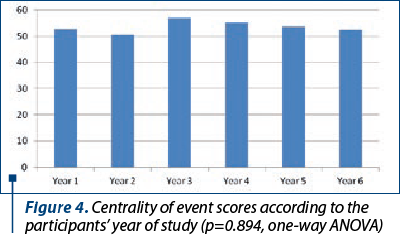
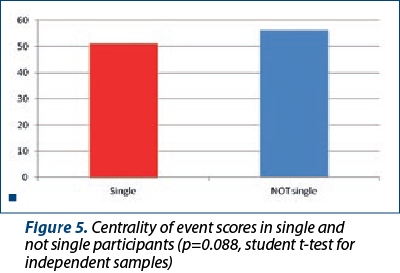
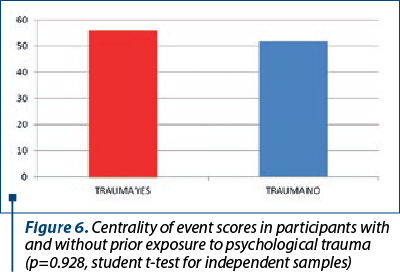
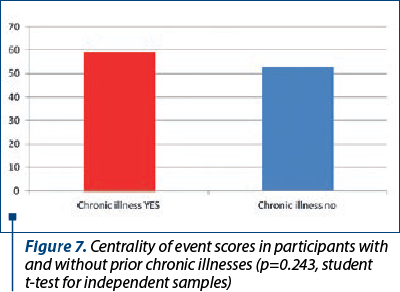
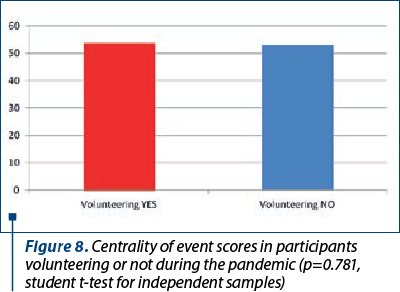
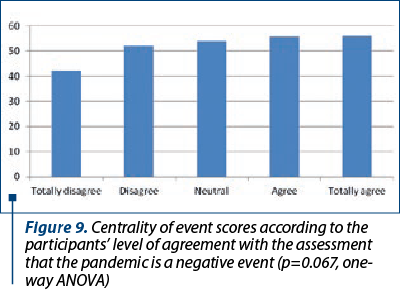
Discussion
Our study ascertains average levels of life-altering perception of COVID-19 pandemic in the Romanian medical students from the sample. Moreover, men and women in the sample report similar levels of life-altering perception of COVID-19 pandemic (53 and 53.31, respectively). The third-year students in the sample report the highest levels of life-altering perception of COVID-19 pandemic, while second-year counterparts have the lowest levels of life-altering perception of COVID-19 pandemic; however, the differences across the years of study are not statistically significant. Single participants report lower levels of life-altering perception of COVID-19 pandemic than counterparts who are not single. The participants with a prior exposure to psychological trauma report higher levels of life-altering perception of COVID-19 pandemic than nonexposed counterparts. The participants with chronic illnesses prior to the pandemic report higher levels of life-altering perception of COVID-19 pandemic than the counterparts without chronic illnesses. Last but not least, the participants who volunteered during the pandemic report higher levels of life-altering perception of COVID-19 pandemic than counterparts who did not. Nevertheless, all aforementioned clinical differences are not statistically significant.
Almost half of the medical students included agree that the pandemic is a negative event, a quarter of them neither agree, nor disagree, while another quarter disagree. The stronger the degree of agreement that the pandemic is a negative event, the higher the participant’s perception that the COVID-19 pandemic is life-changing. Although the differences in pandemic centrality across samples are not statistically significant, there is an important clinical difference between participants who totally disagree that the pandemic is a negative event and report the lowest levels of life change due to the pandemic, and the other students, including those who partially disagree that the pandemic is a negative event.
Quite a few studies address the psychological and social impact of the pandemic in youth, students, and medical students, respectively. Nevertheless, our study is the first to use the life-altering perception of COVID-19 pandemic as psychological impact measure. Other studies employ measures for posttraumatic stress, depression, anxiety and health-related concerns to address the impact of the pandemic in the respective populations(10,11). Our study addresses the pandemic overall as life-altering event for medical students, without focusing on specific components of the pandemic experience. Other studies on student populations focus on the pandemic impact on the teaching-learning process, academic opportunities and strains(12-14), and the risk of COVID-19 contagion in students or their families(15).
The limitations of the current study include a cross-sectional design and an uneven distribution of participants across study years. Also, the study did not include an assessment of depression, anxiety, coping mechanisms and of posttraumatic growth. Further studies with a longitudinal design, more homogenous distribution across study years, including more comprehensive assessments of psychological distress, quality of life, posttraumatic growth and qualitative assessments of the subjective experience of the pandemic for medical students will address these limitations and provide additional data regarding the factors involved in the perception of the pandemic as a negative life-changing event.
Conclusions
The reported life-transforming level of the COVID-19 pandemic, one year after the first wave lockdown measures, is directly associated with the level of perceived stress in Romanian medical students, both as a whole, and in male ones.
The higher the level of agreement of Romanian medical students with the assessment that the COVID-19 pandemic is a negative event, the higher the reported life-transforming level of the COVID-19 pandemic, one year after the first wave lockdown measures.
Romanian medical students who totally disagree with the assessment that the COVID-19 pandemic is a negative event report lower life-transforming levels of the COVID-19 pandemic, one year after the first wave lockdown measures, compared with counterparts who assess the pandemic more negatively.
In Romanian medical students, age, study year, partnership status, prior history of trauma exposure and chronic illness, self-harm, risk taking and volunteering as a form of social connectedness are not associated with the reported life-transforming level of the pandemic, one year after the first wave lockdown measures for the COVID-19 pandemic prevention.
Acknowledgments. The authors wish to acknowledge Carina-Maria Crişan and Andreea Cuciovan, graduates class of the year 2021 of the Faculty of Medicine, “Iuliu Haţieganu” University of Medicine and Pharmacy, Cluj-Napoca, as recruiters for participants.
Bibliografie
Herţa D-C, Miclea B, Trifu R, Cozman D. The psychological trauma of COVID-19 exposure. Psihiatru.ro. 2021;65(2):6-9.
Osofsky JD, Osofsky HJ, Mamon LY. Psychological and social impact of COVID-19. Psychological Trauma. 2020:12(5);468-9.
Qiu D, Li Y, Li L, He J, Ouyang F, Xiao S. Prevalence of post-traumatic stress symptoms among people influenced by coronavirus disease 2019 outbreak: A meta-analysis. Eur Psychiatry. 2021 Apr 12;64(1):e30.
O’Byrne L, Gavin B, McNicholas F. Medical students and COVID-19: the need for pandemic preparedness. J Med Ethics. 2020 Sep;46(9):623-626.
Abdulghani HM. Association of COVID-19 pandemic with undergraduate medical students’ perceived stress and coping. Psychol Res Behav Manag. 2020;13:871–81.
Griffin G. Defining trauma and a trauma-informed COVID-19 response. Psychological Trauma. 2020;12(S1);S279-80.
Berntsen D, Rubin DC. The Centrality of Event Scale: A Measure of Integrating a Trauma into One’s Identity and its Relation to Post-Traumatic Stress Disorder Symptoms. Behav Res Ther. 2006 Feb; 44(2): 219–231.
Cohen S, Kamarck T, Mermelstein R. A global measure of perceived stress. J Health Soc Behav. 1983;24:385–396.
Vrouva I, Fonagy P, Fearon PR, Roussow T. The risk-taking and self-harm inventory for adolescents: development and psychometric evaluation. Psychol Assess. 2010 Dec;22(4):852-65.
Cénat JM, Blais-Rochette C, Kokou-Kpolou CK, Noorishad PG, Mukunzi JN, McIntee SE, Dalexis RD, Goulet MA, Labelle PR. Prevalence of symptoms of depression, anxiety, insomnia, posttraumatic stress disorder, and psychological distress among populations affected by the COVID-19 pandemic: A systematic review and meta-analysis. Psychiatry Res. 2021 Jan;295:113599.
Chang JJ, Ji Y, Li YH, Pan HF, Su PY. Prevalence of anxiety symptom and depressive symptom among college students during COVID-19 pandemic: A meta-analysis. J Affect Disord. 2021 Sep 1;292:242-254.
Ferrel MN, Ryan JJ. The Impact of COVID-19 on Medical Education. Cureus. 2020 Mar 31;12(3):e7492.
Lyons Z, Wilcox H, Leung L, Dearsley O. COVID-19 and the mental well-being of Australian medical students: impact, concerns and coping strategies used. Australas Psychiatry. 2020 Dec;28(6):649-652.
Zis P, Artemiadis A, Bargiotas P, Nteveros A, Hadjigeorgiou GM. Medical Studies during the COVID-19 Pandemic: The Impact of Digital Learning on Medical Students’ Burnout and Mental Health. Int J Environ Res Public Health. 2021 Jan 5;18(1):349.
Hjiej G, Fourtassi M.Medical students’ dilemma during the Covid-19 pandemic; between the will to help and the fear of contamination. Med Educ Online. 2020 Dec;25(1):1784374.





